
In the land of Aquitaine...
June 18, 1998
West Virginia University
in Vendée, France

In the land of Aquitaine...
June 18, 1998
Leaving Les Sables around 9:00 am on this June 18 (the anniversary of De Gaulle's 1940 national call to action in the wake of the German invasion), we travel across Vendée, through Luçon where Richelieu began his glorious career and then by the village of Nieul-sur-l'Autize, where Eleanor of Aquitaine, queen of France and of England, was born in 1122. We thus enter into what was once the Gulf of Pictons and then into the swamps the Marais Poitevin that were first tamed by the monks of the Middle Ages who hoped the chase from the region the criminals that hid in these misty glades and also to create arable land which they could exploit to the profit of their orders. Below, the WVU-Vendéens board the "plates", small flat barks which will take them into the swamps which are in their own way medieval monasteries.
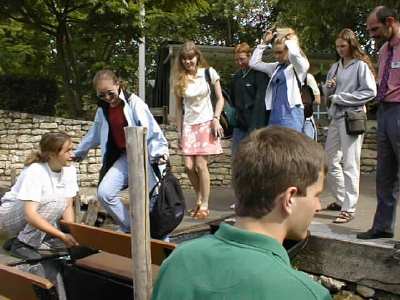
The canals we follow, and which have earned this area its nickname of "Green
Venice", originally served to drain the "useless" and noxious waters from
the lands here. The place on the shore is a site where the monks and lords of the
region gathered to collect tributes to pay for the manual labor that dug and maintained
the canals. Along the edge, the water and the stones were used to wash clothes and
clean other items of daily use.
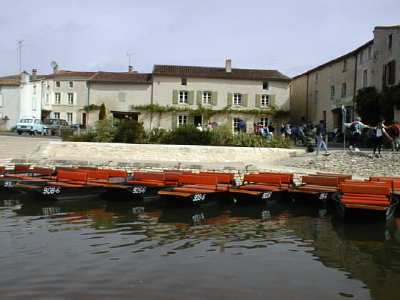
Here, we work our way through the swamps with our guides who are both historians
and serious athletes -- the trip will take one and a half hours and will be commented and
rowed all the way by one and the same person.
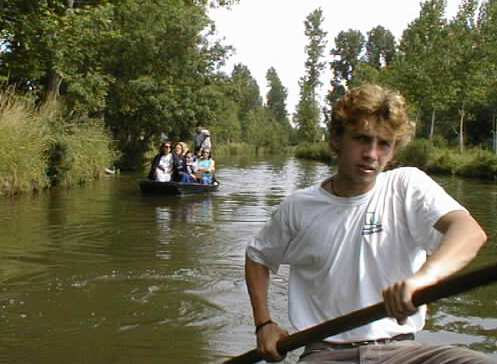
The lands made usable by the canals that both drained the parcels and provided
transportation to and from them are now of relatively small economic value. In their
day, however, they were a major source of wealth. The land produced (and still
does to some extent) a wide variety of crops and grazing for livestock. Below, the
ash tree along the bank provides a root structure that helps maintain the walls of the
canals and also provides a source of firewood and medicinal leaves. In days past the
trees were cut just above the enlargened area we see below. The limbs were used for
firewood and the leaves and bark for teas and medicines. These are but a few of the
precious commodities provided by the rich lands here.
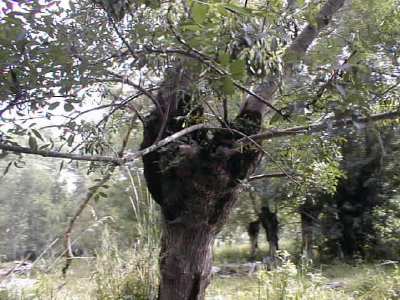
Riding in a "plate" is perhaps easier than guiding and propelling one
through these waters.
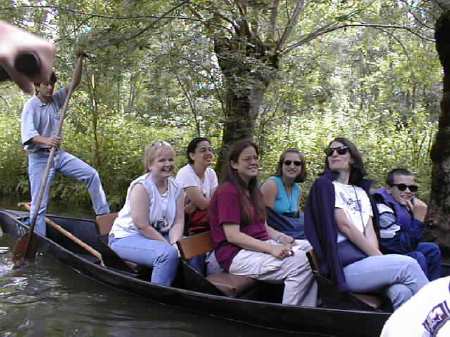
No matter what the effort, however, a ride through the swamp can build a good
appetite. Here we pause for a traditional luncheon near the entry of the
swamps. Some of our WVU-Vendéens still don't quite see why the French make such a
big deal over their food. Others, however, have understood completely... In
all cases, the pause and good company is fully appreciated.
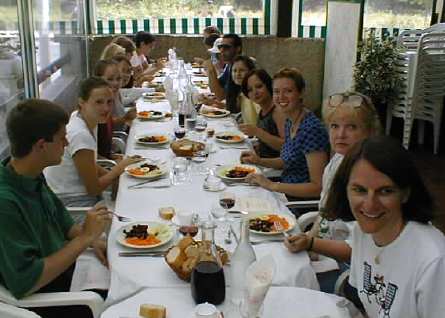
After lunch we visit the ruins of what was once among the richest monasteries in Europe. The Abbaye of Maillezais is built on what was originally an island in the Gulf of Pictons. Over the centuries, however, both nature and man worked in concord to fill the Gulf with the rich sediment makes the area's soil so productive. Today, these ruins stand almost 30 kilometers from the sea. In the days after the fall of the Romans, this island was a strategic location for those wishing to defend or attack the rich surrounding lands. The early Dukes of Acquitaine thus fortified the area in order to fend of the marauding Vikings that would eventually settle in Normandy further north. Those very Vikings, still not content with their holdings, would in 1066 invade the massive island nation of Great Britain, where William the Conqueror would establish his Normans as rulers on both sides of the "English" Channel. The "English" would not soon forget the pleasurable conditions of life they had witnessed along the coast of Acquitaine. Yet, their conquest of this land would not be by military means -- nor would it be direct. In the mid 12th century, all seemed lost for the Normans when the great Duchess of Acquitaine, ruler of vast domains in what is now the south and west of France, accepted to marry the soon to be king of France, Louis VII. After some years of a tumultuous marriage with the independent minded Eleanor and after the production of no male heir, King Louis repudiated his wife, thus releasing Acquitaine from his control. Eleanor was not long in deciding to marry one Henry Plantagenet, heir to William the Conqueror, and thus Duke of Normandy and King of England. This is but one of the chapters of the four-hundred-year saga (The Hundred Years' War being just the last installment) in which the definition of what was "French" and "English" would be a very dubious matter. Eleanor's son, Richard the Lion-Hearted, for example, was at times best friends and mortal ennemies with the great French king Philippe-Auguste, crusader and builder of cathedrals and universities.
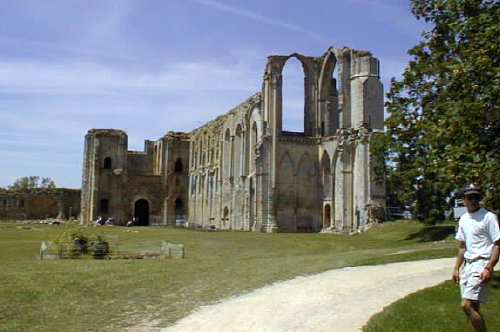
The ruins of Maillezais contain elements of art running from the Romanesque style of the 11th century through the Renaissance style of the 16th century. Below are the Gothic arches of the 12th and 13th centuries.
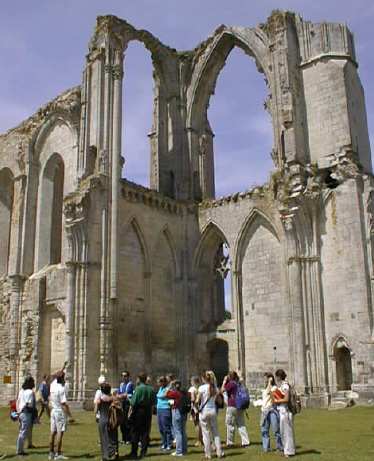
Below is the area that would be the crypt of a church in full preservation. These tombs date back to before the year 1000.
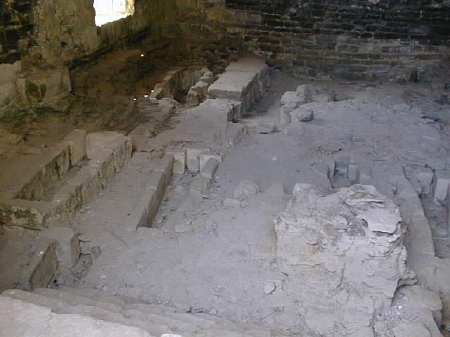
This monastery thrived up untill the time of the Wars of Religion, the battles of the 1500's that divided France between Catholic and Protestant much the way the American Civil War divided us between North and South. Conquered by the Protestants during these wars, the monastery ceased its ordinary workings and fell to neglect. The inhabitants of the area soon began taking the stones from its structures to build in the nearby towns. The artefacts that remain are the product of archeological digs that have uncovered stones like the 12th-century pillar top below.
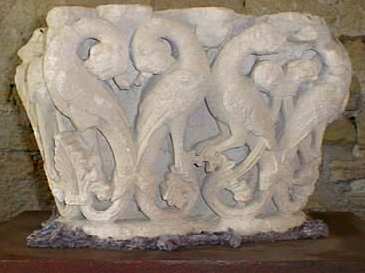
Art here continued to thrive up until the final days of the monastery. Below we see a carving from the Renaissance (1500's) where the fleshy outlines of the central figure are topped off with the shell which is symbol of Saint Jacques de Compostelle. Due to a legend that Saint James had landed in the Spanish village to the south of here, a large portion of the Christian population of the Middle Ages passed through on the way to what was considered the holiest place in Europe after Rome. At every stop the pilgrims brought tribute to the house that received them.
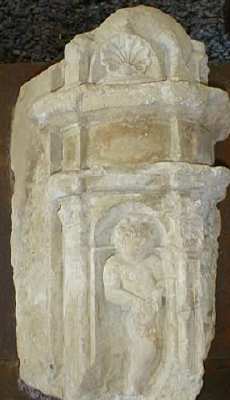
The pilgrims on their holy voyages were one source of wealth here, but so we
the salt swamps that filled the treasure room below with one of the most precious
commodities of the day. This room is now occupied with those anxious to fill their
minds with the treasures of times gone by...
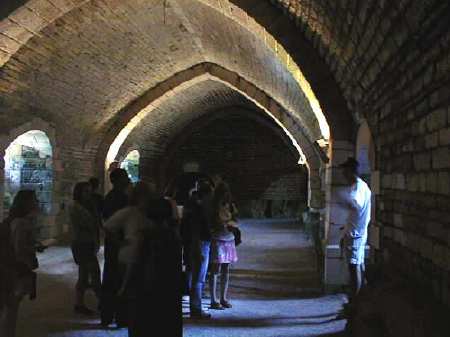
Stay tuned to WVU-V!
Go on to June 21, 1998.